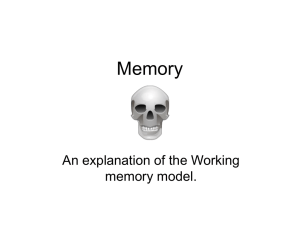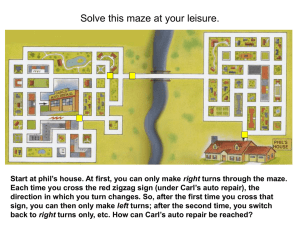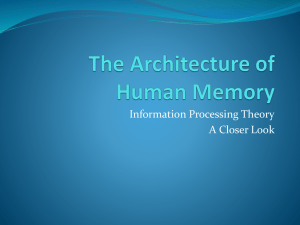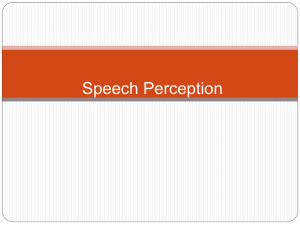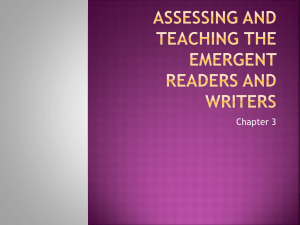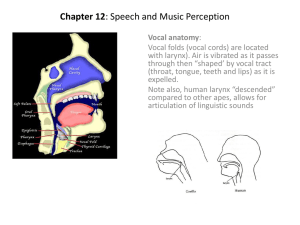Microsoft PowerPoint presentation
advertisement
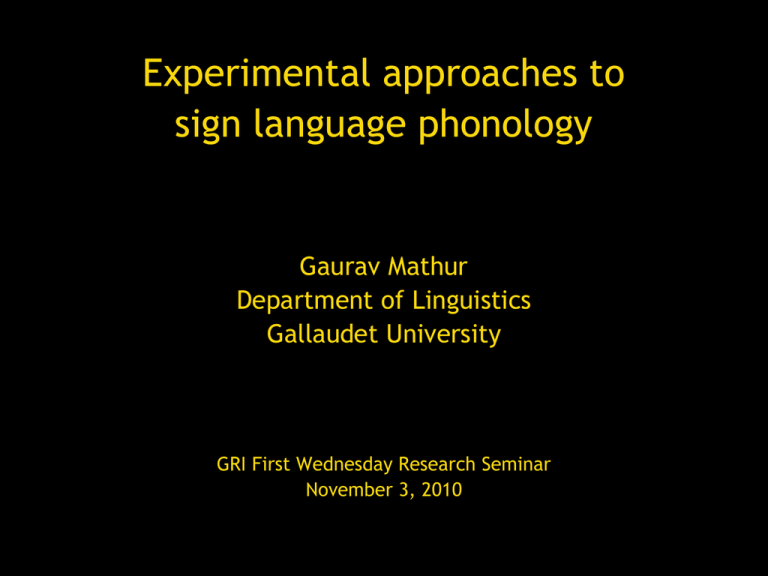
Experimental approaches to sign language phonology Gaurav Mathur Department of Linguistics Gallaudet University GRI First Wednesday Research Seminar November 3, 2010 Main question What belongs to the phonological knowledge of a signed language? An indirect way to address the above question: Which phonological properties affect the perception of a signed language? Why an experimental approach? • Scarcity of minimal pairs for each feature • Difficulty in obtaining paradigmatic alternations • Experimental approach provides a controlled, systematic approach to uncovering features that affect perception (and production) Minimal contrasts • Minimal contrasts are pairs of the smallest possible values that affect meaning • What constitute minimal contrasts under handshape, location and movement? • Example: 1 (CANDY) vs. X (APPLE) in ASL – is contrast between handshapes as whole? OR – is contrast between finer-grained features of handshape, such as extending vs. flexing knuckle? Minimal contrasts • Which minimal contrasts are specific to one signed language, and which appear across many signed languages? • Example: – 1 vs. B seems contrastive in many SLs – U vs. V is contrastive in ASL. In others too? Minimal contrasts: scenario 1 BSL ASL DGS little overlap => less impact of modality on phonology Minimal contrasts: scenario 2 BSL ASL more overlap => DGS greater impact of modality on phonology Why an experimental approach? •Addresses additional issues: • modality differences in perception • effect of age of acquisition on phonological perception Roadmap • Previous studies of SL perception • Categorical perception • Primed lexical decision • Primed phonological matching • Discussion Roadmap • Previous studies of SL perception • Categorical perception • Primed lexical decision • Primed phonological matching • Discussion Previous studies of SL perception • Gating (Emmorey & Corina 1990) • Phoneme monitoring (Corina & Hildebrandt 2002) • Similarity judgment (Corina & Hildebrandt 2002) • Word segmentation (Brentari 2006) • Sign spotting (Morgan, Orfanidou, & Adam 2007) • Categorical perception • Lexical decision Roadmap • Previous studies of SL perception • Categorical perception • Primed lexical decision • Primed phonological matching • Discussion Categorical perception 100 % /b/ Discrimination Categorization 0 p Voicing b • Categorization: clear boundary between two categories • Discrimination: good across boundary, but poor within boundary Categorical perception • CP has several limitations as the sole evidence for human specialization for speech perception: – Strength depends on type of sound: stops vs. fricatives, approximants vs. vowels – Occurs in other domains: localization, vision – Occurs with non-humans: monkeys, rodents, birds • Inspite of those limitations, CP still shows language-specific tuning (Miyawaki et al., MacKain, Best & Strange, Best & Strange, Hallé et al.) • Thus CP is still a useful tool to probe effects of language experience on perception Categorical perception Newport (1982) Location: none Handshape: none Emmorey, McCullough and Brentari (2003) Location: none Handshape: yes for A vs. B-bar, 5 vs. 3 Baker, Idsardi, Golinkoff and Petitto (2005) Handshape: yes for A vs. B-bar, 5 vs. flat-O Our study of CP in ASL • Similar as possible to speech CP studies – Procedure – Stimuli • Handshape: minimal feature contrast • Dynamic: key property of real signs • Based on natural productions • Real/natural appearance • Nonce signs (pseudo-signs) Best, Mathur, Miranda, DeWitt and Lillo-Martin (2010) Is the middle sign the same as the first or last? Is the middle sign the same as the first or last? Is the middle sign the same as the first or last? Results - Categorization Deaf Early Signers Hearing Naive Subject s 4 100 90 80 70 3 50 40 2 30 20 10 80 70 3 60 50 40 2 30 20 10 1 0 0 U 1 2 3 4 5 Stimulus Item 6 7 8 V 9 10 1 0 0 1 U 2 3 4 5 Stimulus Item 6 7 8 V 9 10 Mean Rating 60 Mean % Identification as 0 (U) 90 Mean Rating Mean % Identification as 0 (U) 4 100 Results - Categorization Hearing Late Signers Deaf Lat e Signers 4 100 90 80 70 50 40 2 30 20 10 80 70 3 60 50 40 2 30 20 10 1 0 0 1 U 2 3 4 5 Stimulus Item 6 7 8 V 9 10 1 0 0 1 U 2 3 4 5 Stimulus Item 6 7 8 V 9 10 Mean Rating 60 Mean Rating 3 Mean % Identification as 0 (U) 90 Mean % Identification as 0 (U) 4 100 Results - Discrimination Deaf Early Signers Hearing Naive Subjects 100 y = 0 .0 5 5 52x- 3 .5 3 3 8 x + 9 3 .2 7 4 y = -0 .0 1 7 62x- 3 .7 4 0 8 x + 1 0 0 .1 6 Mean % Correct Discrimination Mean % Correct Discrimination 100 90 80 70 60 50 90 80 70 60 50 0 ,2 1 ,3 2 ,4 3 ,5 4 ,6 5 ,7 St imulus Pair 6 ,8 7 ,9 8 ,1 0 0 ,2 1 ,3 2 ,4 3 ,5 4 ,6 5 ,7 St imulus Pair 6 ,8 7 ,9 8 ,1 0 Results - Discrimination Hearing Late Signers Deaf Late Signers 100 100 y = -0 .4 3 0 22x+ 2 .0 5 1 9 x + 8 5 .0 3 Mean % Correct Discrimination Mean % Correct Discrimination y = -0 .7 8 3 32x+ 3 .3 1 2 x + 9 4 .7 0 2 90 80 70 60 90 80 70 60 50 50 0 ,2 1 ,3 2 ,4 3 ,5 4 ,6 5 ,7 St imulus Pair 6 ,8 7 ,9 8 ,1 0 0 ,2 1 ,3 2 ,4 3 ,5 4 ,6 5 ,7 St imulus Pair 6 ,8 7 ,9 8 ,1 0 Results - Summary • Categorization similar to that seen in speech studies, but independent of language experience • Ratings most differentiated for late learners • Discrimination different from that seen in speech studies: better at U end, worse at V end • Interaction between hearing status and language experience: deaf late signers were the best at discrimination, and the hearing late signers the worst Discussion: Psychophysical effect • Greater sensitivity to small differences in finger-spreading at the U end of the continuum suggest a visual psychophysical effect in the perception of some phonetic contrasts in ASL. • Thus not all linguistic contrasts may be necessarily perceived categorically; rather, they may be perceived psychophysically. Discussion: Language experience • Late exposure to language may enhance signers’ discrimination possibly because the late signers’ perception is based heavily on phonological form relative to semantic content (cf. Mayberry 1993). • Other experimental tools than CP, like those based on response time, can probe more deeply such effects of language experience on the perception of linguistic contrasts. Roadmap • Previous studies of SL perception • Categorical perception • Primed lexical decision • Primed phonological matching • Discussion Lexical Decision • Task: press green button if target is real • If prime is related to target, response is faster • Why? prime sets up expectation for target a) b) PRIME TARGET xxx xxx --> normal xxx xxx --> faster Lexical decision Corina and Emmorey (1993) Location inhibitory Movement facilitatory Corina and Hildebrandt (2002) Location no priming effect Movement no priming effect Dye and Shih (2006) for BSL Location + Movement facilitatory Deaf late signers: Mvt. sufficient, slower Our study Other studies: HS: Loc: Mvt: Prime Target different same same Our design: HS: Loc: Mvt: Prime Target same different different more analogous to spoken priming, in which one phoneme is same tested 12 different values for each parameter Is the second sign real? Is the second sign real? Is the second sign real? Is the second sign real? Results Target: REAL better and faster Prime: REAL faster and marginally better Target x Prime: (significant only for RT) i) equally fast for REAL targets and primes ii) slow for NONCE signs ii) even slower for NONCE primes Results Relatedness: (significant only for RT) faster for related primes Relatedness x Target: i) better and faster for nonce signs if related ii) even better and faster for real signs but regardless of relatedness Results Relatedness x Target x Prime x Parameter: Accuracy was facilitated when target and prime shared location, especially for real primes and targets Summary of results • There was a lexical priming effect: – lexical decisions more accurate for real targets – faster reaction to real targets • There was a priming effect due to the parameters: – lexical decisions more accurate when prime and target related – faster reaction to related pairs relative to unrelated pairs Compared with previous studies? Consistent with previous studies (e.g. Emmorey 1991, Corina and Emmorey 1993) that have found phonological priming in ASL Why different results for handshape and movement vs. location? Previous studies have also found different results for each parameter: – Hildebrandt and Corina (2002): if two signs share location and movement, they are judged to be most similar – Dye and Shih (2006): if prime and target share location and movement, response is fastest Possible account: – Handshape and movement consistute the essential units of phonological structure – Location tied to movement Roadmap • Previous studies of SL perception • Categorical perception • Primed lexical decision • Primed phonological matching • Discussion Design issue Previous studies focused on the distinction between the parameters of handshape, location and movement. What about the finer-grained or atomic features of the parameters? Do they have an effect on the perception of a SL? Finer-grained features Handshape - finger selection - finger configuration Location - major location - further specification, e.g. ipsi vs. contra Movement - articulatory (joints of hand/arm) - visual (shape traced by movement of hand/arm) A novel task Challenge to control for finer-grained features on perception with real signs Primed phonological matching provides another way to get around that issue Design based on Katz, Trudeau, & Best (in preparation) Primed phonological matching • View three nonsigns produced by different signers • First sign is prime • Last two signs are either same or differ in one of the three parameters • Must judge if the last two signs are same Are the last two signs the same? Are the last two signs the same? Priming relationships 1) Phonological condition prime and second sign share same value of one parameter (e.g. same handshape) 2) Articulatory condition prime and second sign share finer-grained value for one parameter that has an articulatory basis (e.g. same knuckle) 3) Visual condition prime and second sign share finer-grained value for one parameter that has a visual basis (e.g. same quantity of fingers) Articulatory condition Handshape: use same joints of the arm to make configuration, e.g. bent V and bent W Location use same joints of the arm to reach location, e.g. contra chest and upper arm Movement use same joints of the arm to produce movement, e.g. forehead to nose and downward movement in neutral space Prime is articulatorily related - H Prime is articulatorily related - L Prime is articulatorily related -M Visual condition Handshape: use same quantity of fingers, e.g. 1 and X Location use locations on same horizontal plane, e.g. nose and cheek Movement use same shape of movement traced by the hand/arm, e.g. small arc from forehead and bigger arc in neutral space Prime is visually related - H Prime is visually related - L Prime is visually related - M Advantages of design Can verify whether phonological condition improves accuracy facilitates response time Can determine whether articulatory/visual condition (finer-grained features) inhibits response time helps distinguish between parameters and finer-grained features implications for sign phonology Further advantages of design 1. Cross-linguistic comparisons 2. Age of acquisition Cross-linguistic comparisons • Adapt phonological matching experiment for various SLs (e.g. BSL, DGS, ASL) • Determine whether effects of parameters and finer-grained features are specific to one SL or appear in many SLs Age of acquisition Compare performance on different Age of Acquisition groups - native - early - late => determines what belongs to native knowledge of sign phonology Roadmap • Previous studies of SL perception • Categorical perception • Primed lexical decision • Primed phonological matching • Discussion Discussion • Phonological features of a sign language do influence sign perception • The different phonological features of a sign (handshape, location and movement) affect sign perception in different ways. Modality In studies of spoken language priming, there is also evidence that different parts of phonological structure have different priming effects (e.g. consonants vs. vowels) suggests hierarchy in phonological structure in both modalities content of hierarchy different in each modality processing may be serial for spoken languages, and parallel for signed languages Directions for Future Research • More phonetic features (visual and articulatory) • Parameter of orientation • Cross-linguistic comparisons • Comparison of L1, delayed L1 and L2 • Other perceptual techniques Acknowledgments All the participants in our studies Catherine Best Ian DeAndrea-Lazarus Kirsi Grigg-Langdon Christopher Kearney Diane Lillo-Martin Brooke Sahlin Martha Tyrone and support from an NIH grant to the Haskins Laboratories, Gallaudet Priority Research grant, and ESRC Collaborative Visiting Fellowship For questions/copy of handout: gaurav.mathur@gallaudet.edu

